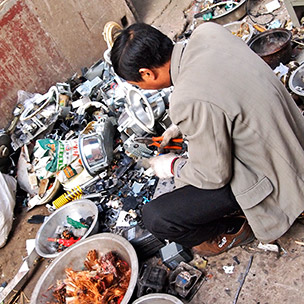April 21, 2015 — When we think of e-waste, we tend to think of phones, computers, printers and the like. But that’s just the tip of the iceberg. According to a first-ever global look at the production, impacts and management of electrical and electronic waste released this week by the United Nations University, of the 46.1 million tons (41.8 million metric tons) of e-waste produced in 2014, nearly two-thirds was made up of far more mundane objects such as vacuum cleaners, dishwashers, toasters, washing machines and other home and business equipment.
According to the report, “Global E-Waste Monitor 2014,” the e-waste problem is growing fast, thanks to increasing demand for, and shortening useful lives of, electrical and electronic products. At the same time, relatively little is recycled or reused, so huge amounts of valuable materials end up landfilled or in developing countries, where lax standards create huge environmental and health hazards. By illustrating how much e-waste is produced worldwide, where it’s generated and its fate, the report seeks to showcase the tremendous opportunities for recyclers, reusers and take-back programs to turn trash to treasure.
Among the report’s findings:
- Just two countries — the U.S. and China — produced nearly one-third of all e-waste in 2014.
- Per capita leaders were Norway, Switzerland, Iceland, Denmark and the United Kingdom.
- Less than one-sixth of end-of-life electrical and electronic products are estimated to have been recycled or reused in 2014.
- The 2014 e-waste burden included an estimated 18.2 million tons (16.5 million metric tons) of iron, 2.1 million tons (1.9 million metric tons) of copper and 330 tons (300 metric tons) of gold, as well as silver, aluminum and other valuable materials.
- The “intrinsic material value” of global e-waste in 2014 was an estimated US$52 billion.
- The amount of e-waste is predicted to increase to 54.9 million tons (49.8 million metric tons) by 2018.
“Worldwide, e-waste constitutes a valuable ‘urban mine’ — a large potential reservoir of recyclable materials. At the same time, the hazardous content of e-waste constitutes a ‘toxic mine’ that must be managed with extreme care,” U.N. under-secretary-general David Malone said in a news release announcing the report’s release. “[This] provides a baseline for national policymakers, producers and the recycling industry to plan take-back systems. It can also facilitate cooperation around controlling illegal trade, supporting necessary technology development and transfer, and assisting international organizations, governments and research institutes in their efforts as they develop appropriate countermeasures.”
Download the 80-page report here.
![]()
Photo by Remko Tanis (Flickr | Creative Commons)
Ensia shares solutions-focused stories free of charge through our online magazine and partner media. That means audiences around the world have ready access to stories that can — and do — help them shape a better future. If you value our work, please show your support today.
Yes, I'll support Ensia!
